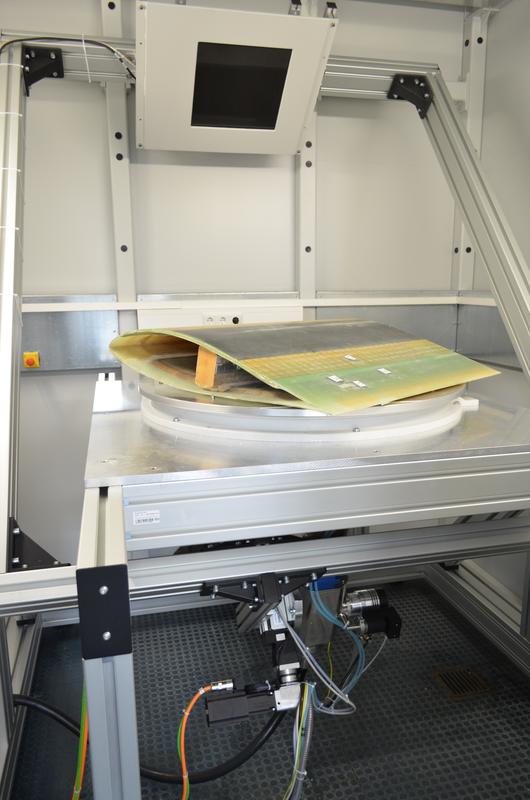Production-integrated inspection of large-scale CFRP components

CLARA<sup>®</sup>: Computer Laminography and radiography system Fraunhofer IZFP
In lightweight construction or in aviation application of fiber-reinforced plastics (FRP) is steadily rising. FRP components are often used in form of very large or flat shapes, which can be examined using the Fraunhofer IZFP’s CL device CLARA® (Computer Laminography and radiography system). As nondestructive inspection of complex components and materials is increasingly required along the entire material cycle but especially during the production process, the development of new, time-saving and cost-effective testing methods is essential.
CT as a widespread X-ray method can obtain high-resolution 3D volume images to depict the finest structures and details. But considering in particular objects, where CT is unsuitable, CL is an efficient and effective alternative. “While in medicine CL is widely used, industrial applications are seldom to found despite some outstanding advantages compared to CT”, Dr. Michael Maisl explains, senior scientist and group manager of the “Reconstruction, Image Processing, CT/CL by X-ray” group at Fraunhofer IZFP.
Unlike CT, CL is perfectly suited for high-resolution inspection of large or planar components. Compared to CT, the inspection time can be significantly reduced. Additionally, a variety of different recording shapes is available, which also enable adjustments to perform fully automated batch inspection.
Similar to CT, radiographs are taken from different angles to compute a three-dimensional representation of the object’s internal structure using a reconstruction algorithm.
Unlike CT, however, the rotation axis is not orthogonal, but inclined to the beam direction. “By this inclination the otherwise inevitable collision between the object and the source or the detector can be avoided. The arrangement ensures the penetration of the object covering any necessary irradiation angles. As a consequence the individual section planes can be reconstructed at any relevant resolution and represented adequately, “Maisl adds.
Traditionally, CL is used for the examination of electronic circuit boards. Recent application areas are related to modern lightweight materials such as fiber reinforced plastics (CFRP, GFRP), which are increasingly common, also in the form oversized parts for wind turbines or in automobile industry and in aviation. Further applications concern the defect inspection of parts or components, e.g. the detection of porosities or inclusions in car body parts or the detection of micro-cracks in photovoltaic modules.
Media Contact
All latest news from the category: Trade Fair News
Newest articles

Webb captures top of iconic horsehead nebula in unprecedented detail
NASA’s James Webb Space Telescope has captured the sharpest infrared images to date of a zoomed-in portion of one of the most distinctive objects in our skies, the Horsehead Nebula….

Cost-effective, high-capacity, and cyclable lithium-ion battery cathodes
Charge-recharge cycling of lithium-superrich iron oxide, a cost-effective and high-capacity cathode for new-generation lithium-ion batteries, can be greatly improved by doping with readily available mineral elements. The energy capacity and…

Novel genetic plant regeneration approach
…without the application of phytohormones. Researchers develop a novel plant regeneration approach by modulating the expression of genes that control plant cell differentiation. For ages now, plants have been the…





















